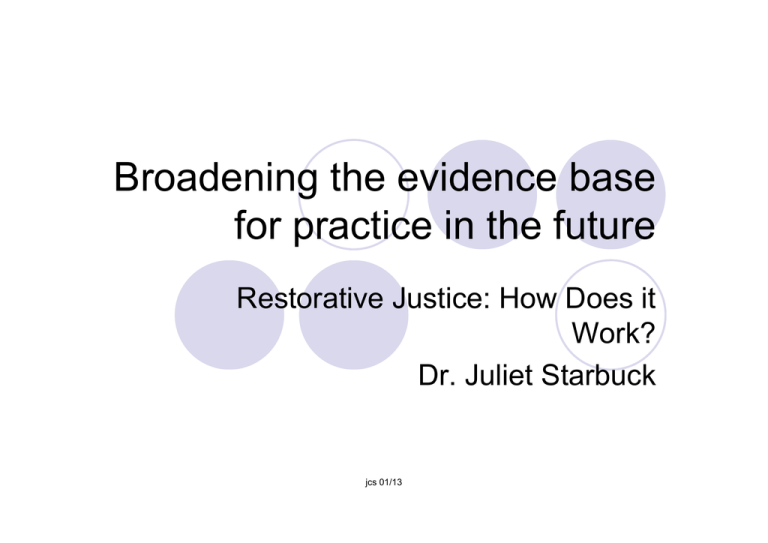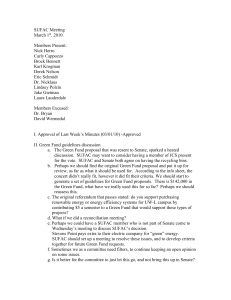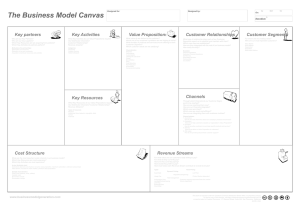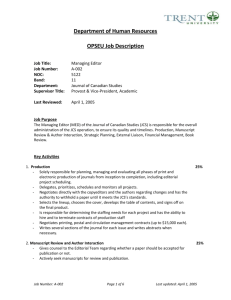Broadening the evidence base for practice in the future Work?
advertisement

Broadening the evidence base for practice in the future Restorative Justice: How Does it Work? Dr. Juliet Starbuck jcs 01/13 Restorative Justice To show that: zEP research can lay the basis for improving the ways in which schools respond to tension and conflict zcase study research methods can be deployed in rigorous and persuasive ways jcs 01/13 Restorative Justice z How H d do restorative t ti jjustice ti conferences f work? k? Can the impact of an RJ Conference be explained by Causal Attribution Theory? z How H and d why h d do stakeholders’ t k h ld ’ causall attributions for aggressive/violent/conflict situations differ before and after a restorative justice conference? jcs 01/13 Causal Attribution Theory (Weiner (Weiner, 2006) zan understanding about cause and perceptions p p of intent zto inferences about personal responsibility zto t emotions ti off anger and d sympathy th to soc social a reactions eact o s which c might g t include c ude zto help-giving, reprimand, aggression and retaliation. retaliation jcs 01/13 The Restorative Justice Conference z a meeting ti which hi h ffollows ll a structured t t d fformatt z the same set of questions is always asked by a t i d ffacilitator trained ilit t z both parties in a conflict must be there z they can bring ‘supporters’ (parents if youths) z everyone sits in a circle z all parties are helped to reflect on their actions and how these have impacted on others z an agreement is reached about what needs to be done to repair the harm caused jcs 01/13 Propositions z Proposition 1: It is predicted that the harmed (and their supporters) will describe feelings of anger and thoughts of reprimand and/or other negative reactions following an initial harmful act against them. z Proposition 2: It is predicted that the wrongdoer who perceived the harmed as responsible for an act of antagonism will, during the pre-conference interview, describe feelings of anger and thoughts of reprimand in response to an initial ‘antagonistic act’ from the harmed. jcs 01/13 Propositions z Proposition P iti 3 3: It iis predicted di t d th that: t (i): The wrongdoer will make fewer inferences of hostility and intention when asked what ‘X’ X thinks (in response to a series of hypothetical vignettes) following attendance at an RJ conference. (ii): The wrongdoer will react less angrily and propose fewer hostile behavioural responses when asked what ‘X’ X feels and does (in response to a series of hypothetical vignettes) after attendance at an RJ conference. z Proposition 4: It is predicted that the harmed will make fewer inferences of hostility and intention when asked what ‘X’ X thinks (in response to a series of hypothetical vignettes) prior to attendance jcs 01/13 at the RJ conference than the wrongdoer. Propositions z Proposition 5 (i): It is predicted that analysis of the conference transcripts will show that during the RJ conference the wrongdoer will confess. This will be according to Weiner’s (2006) description of confession. z Proposition 5 (ii): It is predicted that during the post - conference interview the harmed and their supporters will report that they perceive that the wrongdoer is not an inherently bad person and that th are nott lik they likely l tto commit it the th causall actt again. i z Proposition 5 (iii): It is predicted that the victim and their supporters will have a more positive moral impression of the wrongdoer following the conference conference. z Proposition 5 (iv):It is predicted that the victim and their supporters will have reduced feelings of anger and increased feelings of sympathy when interviewed before attendance at a conference compared with after attendance at a conference. jcs 01/13 Propositions z Proposition 6: It is predicted that a comparison of the wrongdoer’s pre-conference interview and post - conference interview responses will show that the wrongdoer feels better about themselves and will feel that they are not a bad person following participation in the conference. jcs 01/13 Design – a case study A case study is an empirical enquiry that: zinvestigates a contemporary phenomenon within ithi itits real-life l lif context, t t especially i ll when h t e boundaries bou da es bet between ee p phenomenon e o e o a and d zthe context are not clearly evident (Yin, 2003). jcs 01/13 Design z The Th restorative t ti justice j ti conference f was th the case study. z The attributions made by each stakeholder involved in the conference were the unit of analysis. y z A multiple-case design was adopted. Two cases were studied. z A replication strategy was used: it was hoped that similar results would be found in each case. z Multiple sources of evidence were drawn upon to produce the data for analysis. jcs 01/13 Participants Only O l those th people l (th (the stakeholders) t k h ld ) who h were directly involved in the Restorative Justice Conference were included in the study: y z harmed z wrongdoer z school representative z harmed harmed’s s supporter z wrongdoer’s supporter jcs 01/13 The cases The cases were regarded Th d d as ttypical i l att th the point i t off selection because they met the following criteria: z a specific (aggressive) act had occurred between two members of the school community z a specific wrongdoer had been identified z the wrongdoer had acknowledged some degree of responsibility and they were willing to take part in the conference z the harmed was willing to take part in the conference. jcs 01/13 Propositions z A series of propositions was developed which ‘directs attention to something that should be examined within the scope of the study’. g as ‘a ((hypothetical) y ) story y z Each can be regarded about why acts, events, structure and thoughts occur’ (Sutton and Straw, 1995 in Yin, 2003). z The propositions guided decisions about what data to collect and how to analyse this data. jcs 01/13 Data collection zPre and post conference interviews zPre and post conference vignettes zdirect observation zdocumentation jcs 01/13 Results zpattern matching logic was used to y the data collected: “Such a logic g analyse compares an empirically based pattern with a predicted one (or with several alternative predictions)” (Trochim, 1989 in Yin 2003 Yin, 2003, p p.116). 116) p zrival explanations zcross case analysis jcs 01/13 Results zproposition 2 validated in both cases zproposition 3 was validated in both cases zproposition 5(i) was validated in both cases p opos t o 5( 5(v)) was as validated a dated in bot both zproposition cases zproposition 6 was as validated alidated in both cases jcs 01/13 Results z proposition 1 partly validated in both cases proposition p 1 was revised: zp It is predicted that the harmed (and their supporters) will describe feelings of anger and thoughts of reprimand, and/or other negative reactions, following an initial causal act against them if they perceive the act to have been hostile and the wrongdoer to be responsible for that act. jcs 01/13 z proposition 4 was validated in one case only proposition p 4 was revised: zp it is predicted that any young person who has a bias to interpret ambiguously hostile events as hostile will make fewer inferences of hostility and intention when asked what ‘X’ X thinks (in response to a series of hypothetical vignettes) following attendance at an RJ conference than before attendance at the conference. jcs 01/13 Conclusions zd demonstrates t t th thatt causall attribution tt ib ti th theory, iin particular ti l Weiner’s Theory of Social Motivation, Justice and the Moral Emotions – an attributional approach, pp , can explain p the impact that attendance at a conference has on its stakeholders z shows h why h RJ might i ht work k z identifies potential areas for intervention when supporting young people to avoid conflict situations in school z development p of a monitoring g and evaluation tool to ensure that RJ conferences are carried out properly and that they have an impact jcs 01/13 Any questions? jcs 01/13







